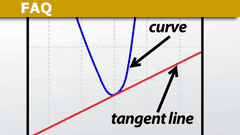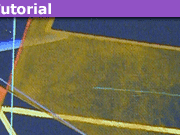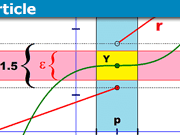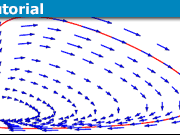What is a Tangent Line? A 5 Minute Introduction
Table of Contents
Definition/Summary
The tangent to a curve in a plane at a particular point has the same Gradient as the curve has at that point.
More generally, the (n-1)-dimensional tangent hyperplane to an (n-1)-dimensional surface in n-dimensional space at a particular point has the same Gradient as the surface has at that point.
So if [itex]A\,=\,(a_1,a_2,\cdots a_n)[/itex] is a point on a surface defined by the equation [itex]F(x_1,x_2,\cdots x_n) = 0[/itex], then the tangent hyperplane to the curve through [itex]A[/itex] is [itex]\frac{\partial F}{\partial x_1}\arrowvert_A(x_1 – a_1)\,+\,\frac{\partial F}{\partial x_2}\arrowvert_A(x_2 – a_2)\,+\,\cdots\,\frac{\partial F}{\partial x_2}\arrowvert_A(x_n – a_n)\,=\,0[/itex]
If a curve in n dimensions is defined using a parameter t as [itex]A(t)\,=\,(a_1(t),a_2(t),\cdots a_n(t))[/itex] , then its tangent is:
[itex](x_1 – a_1) / \frac{da_1}{dt}\,=\,(x_2 – a_2) / \frac{da_2}{dt}\,=\,\cdots\,=\,(x_n – a_n) / \frac{da_n}{dt}[/itex]
Equations
For example, if the point [itex]A\,=\,(x_0,y_0)[/itex] lies on the circle:
[tex]F(x,y)\,=\,(x-p)^2+(y-q)^2\,-\,r^2\,=\,0[/tex] (1)
then [tex]\frac{\partial F}{\partial x}\arrowvert_A\,=\,2(x-p)\arrowvert_A\,=\,2(x_0-p)[/tex]
and [tex]\frac{\partial F}{\partial y}\arrowvert_A\,=\,2(y-q)\arrowvert_A\,=\,2(y_0-q)[/tex]
and so the equation of the tangent at [itex]A[/itex] is:
[tex](x_0-p)(x-x_0)\,+\,(y_0-q)(y-y_0)=0[/tex] (2)
Alternatively, the same circle can be defined by [itex]A(\theta)\,=\,(p+r\cos\theta, q+r\sin\theta)[/itex]
and so the equation of the tangent at [itex]A(\theta)[/itex] is:
[tex]\frac{x-p-r\cos\theta}{-r\sin\theta}\,=\,\frac{y-q-r\sin\theta}{r\cos\theta}[/tex]
Extended explanation
We will transform the equation (2) into more convenient type for better way of memorizing and using the formula. Because of [itex]M(x_1,y_1) /in K[/itex]:
[tex](x_1-p)+(y_1-q)^2=r^2[/tex] (3)
If we sum the equations (2) and (3), we get:
[tex](x_1-p)(x-x_1)+(y_1-q)(y-y_1)+(x_1-p)+(y_1-q)^2=r^2[/tex]
[tex](x_1-p)[x-x_1+x_1-p]+(y_1-q)[y-y_1+y_1-q]=r^2[/tex]
[tex](x_1-p)(x-p)+(y_1-q)(y-q)=r^2[/tex] (4)
The equation (4) is equation of tangent of the circle in the point [itex]M(x_1,y_1) \in K[/itex].
If the K have center (0,0), i.e [itex]K: x^2+y^2=r^2[/itex], then p=q=0, so the equation of the tangent is:
[tex]x_1x+y_1y=r^2[/tex]
Extra
See also https://www.physicsforums.com/insights/the-pantheon-of-derivatives-i/ and the list at the beginning in https://www.physicsforums.com/insights/journey-manifold-su2mathbbc-part/ where I have listed a couple of different views of how a derivative can be seen. The slope wasn’t even among it!
This article was authored by several Physics Forums members with PhDs in physics or mathematics.








Leave a Reply
Want to join the discussion?Feel free to contribute!